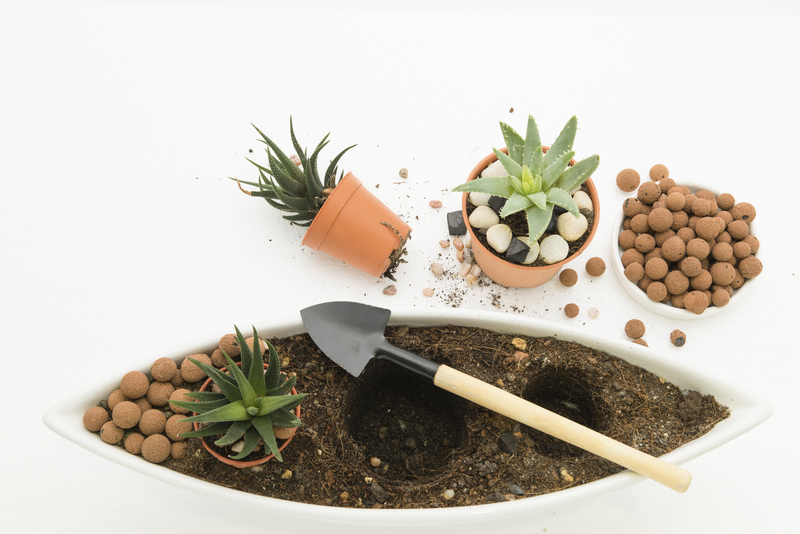Preventative Measures for Safeguarding Your Garden from Severe Weather
Posted on 24/09/2025
Preventative Measures for Safeguarding Your Garden from Severe Weather
Weather can be unpredictable, and in recent years, gardeners have faced increasingly severe storms, droughts, and temperature extremes. Protecting your garden from harsh weather conditions is not just a matter of luck; it demands planning, preparation, and ongoing vigilance. Whether you are cultivating vegetables, flowers, or shrubs, the right preventative measures can make all the difference in preserving the beauty and productivity of your outdoor space.
Understanding the Impact of Severe Weather on Gardens
Before diving into specific preventative strategies, it's crucial to understand how various types of extreme weather can damage your garden. This knowledge will empower you to tailor your garden protection methods to your local climate and the specific needs of your plants.
Common Severe Weather Events
- Heavy Rain & Flooding: Can cause root rot, erosion, and nutrient washout.
- High Winds: Lead to broken stems, uprooted plants, and garden structure damage.
- Severe Heatwaves: Stress plants, dry out soil, and can cause sunburn on leaves.
- Frost & Freezing Temperatures: Damage tender plant tissues, kill seedlings, and harm roots.
- Hailstorms: Shred foliage and bruise or destroy produce and flowers.
- Snow & Ice: Can break limbs, smother perennials, and compact soil.
With these threats in mind, let's explore the comprehensive preventative actions you can take to safeguard your garden from severe weather.

Assessing Your Garden's Vulnerability
Every garden is unique. Conducting a vulnerability assessment is the first strategic step in protecting your garden from severe weather. Here's what to consider:
- Soil Drainage: Does water pool in certain areas during rain?
- Landscape Position: Is your garden on a slope or in a valley where frost may settle?
- Plant Selection: Do you have tender annuals or hardy natives?
- Existing Structures: Are there trees, fences, or buildings to act as windbreaks?
Document your findings, and use them to guide your preventative gardening strategy.
Best Preventative Measures for Garden Weather Protection
There are numerous practical steps you can take to protect your garden from extreme weather events. Employ a combination of these strategies for the best results.
1. Enhance Soil Health and Structure
Healthy soil provides a strong foundation for face adverse weather. Well-structured soil drains efficiently during downpours and holds moisture during droughts.
- Add organic matter: Regularly incorporate compost and aged manure.
- Mulching: Apply a 2-3 inch layer of organic mulch to moderate soil temperature, reduce erosion, and protect roots.
- Soil testing: Check pH and nutrient levels to ensure optimal plant health before weather events.
2. Improve Drainage and Erosion Control
Standing water and erosion are common consequences of severe weather. Proactive drainage management can save your garden.
- Install French drains or swales: Guide excess water away from vulnerable beds.
- Plant ground covers and erosion-control plants: Their roots anchor soil and reduce runoff.
- Use raised beds: Particularly useful in areas with consistently poor drainage.
3. Wind Protection and Structural Supports
High winds can devastate a garden in moments. Provide barriers and strengthen your plants' defences.
- Windbreaks: Plant evergreen shrubs, or erect fences and hedges to buffer strong winds.
- Staking and caging: Secure tall or top-heavy plants with sturdy stakes or cages.
- Temporary covers: Use horticultural fleece, row covers, or tarps during storms.
4. Temperature Extremes: Heatwaves and Frost
Plants often suffer most during sudden temperature swings. Smart planning helps prevent severe damage.
- Shade structures: Install shade cloth, garden umbrellas, or plant deciduous trees for natural summer cooling.
- Frost covers: Drape lightweight fabric or horticultural fleece over susceptible plants at night.
- Watering: Water deeply before heatwaves or freezes since moist soil changes temperature more slowly.
- Hydration: Keep mulch moist to provide humidity and insulation.
5. Protecting Against Hail and Heavy Rain
Hail can destroy months of careful growth in an instant, while heavy rain can flatten vegetation.
- Protective covers: Use mesh, netting, or temporary roofing to shield valued plants during hail forecasts.
- Flexible plant supports: Use bamboo canes or hoop supports to protect sprawling crops and tender perennials.
6. Snow and Ice Preparation
Snow can be both a blanket and a burden for your garden.
- Remove snow gently: Use a broom to brush away heavy snow from shrubs and delicate branches to prevent breakage.
- Avoid salt-based deicers: These can leach into soil and damage plant roots.
- Add mulch late in fall: This insulates roots and helps reduce soil heaving from repeated cycles of freezing and thawing.
7. Smart Plant Choices for Weather Resilience
One of the most effective preventive measures for severe garden weather is to choose plants well-adapted to your local climate.
- Native plants: These are inherently adapted to local weather extremes and require less intervention.
- Drought-tolerant varieties: Consider plants like lavender, sedum, and yarrow for water-efficient gardening.
- Deep-rooting species: Better equipped to survive wind and drought.
Essential Ongoing Maintenance and Vigilance
Preventing weather damage doesn't end after your initial preparations. Regular garden inspections and proactive care are vital for ongoing protection.
- Inspect after storms: Walk through your garden after each event to check for damage and make timely repairs.
- Prune regularly: Remove dead or weak branches that are prone to breaking in strong winds or under snow.
- Maintain supports and barriers: Tighten ties, replace damaged stakes, and check the integrity of windbreaks.
- Seasonal adjustments: Adapt your protective measures as the seasons--and forecast--change.
Advanced Strategies: Modern Technologies for Garden Weather Protection
Leveraging technology can boost your preventative measures for safeguarding your garden from extreme weather events.
- Smart irrigation systems: Use weather-sensing drip irrigation to adjust water supply based on anticipated rainfall or drought.
- Weather monitoring apps: Get real-time local weather alerts to prepare covers or adjust watering schedules.
- Greenhouses and cold frames: Provide full-proof shelter for tender vegetables, seedlings, or tropical ornamentals.
- Remote cameras and sensors: Monitor conditions in the garden without stepping outside, particularly useful for large or remote spaces.
Conclusion: Proactive Planning for a Resilient Garden
While you cannot control the weather, you can take active steps to minimize its impact on your garden. Start by understanding your garden's strengths and weaknesses, employ a combination of structural, horticultural, and technological preventative measures, and commit to regular maintenance.
*The result will be a resilient, vibrant garden that can weather any storm--literally and figuratively. By implementing the preventive strategies covered in this guide, you can ensure your garden continues to flourish, regardless of what Mother Nature may bring.*

Frequently Asked Questions About Preventative Measures for Garden Weather Protection
- What are the best covers for protecting plants during severe weather?
- Horticultural fleece, shade cloth, and mesh netting are effective for different conditions--use fleece for frost or hail, and shade cloth for heatwaves.
- When should I prune plants to minimize storm damage?
- Late winter or early spring is ideal for most woody plants, but always prune out damaged or diseased limbs after a severe event.
- How can I improve my soil's ability to withstand weather extremes?
- Add compost annually, avoid compaction, and use mulch to maintain moisture and reduce erosion.
- What's the role of native plants in weather-proofing gardens?
- Native plants are naturally adapted to local weather extremes, making them more likely to survive long-term.
Additional Resources
- Royal Horticultural Society: Protecting Your Garden From Extreme Weather
- Gardeners.com: Weather Protection Tips
- University of Minnesota Extension: Your Garden and Extreme Weather
Implementing these preventative measures for safeguarding your garden from severe weather ensures that your hard work and investments are protected, no matter what the forecast holds.
```


